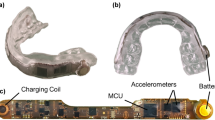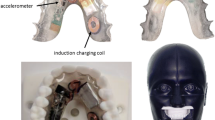Abstract
The purpose of this study was to evaluate a novel instrumented mouthguard as a research device for measuring head impact kinematics. To evaluate kinematic accuracy, laboratory impact testing was performed at sites on the helmet and facemask for determining how closely instrumented mouthguard data matched data from an anthropomorphic test device. Laboratory testing results showed that peak linear acceleration (r 2 = 0.96), peak angular acceleration (r 2 = 0.89), and peak angular velocity (r 2 = 0.98) measurements were highly correlated between the instrumented mouthguard and anthropomorphic test device. Normalized root-mean-square errors for impact time traces were 9.9 ± 4.4% for linear acceleration, 9.7 ± 7.0% for angular acceleration, and 10.4 ± 9.9% for angular velocity. This study demonstrates the potential of an instrumented mouthguard as a research tool for measuring in vivo impacts, which could help uncover the link between head impact kinematics and brain injury in American football.






Similar content being viewed by others
References
Abramowitz, M. and I. A. Stegun. Handbook of Mathematical Functions: With Formulas, Graphs, and Mathematical Tables, Vol. 55. Dover Publications, 1965.
Beckwith, J. G., J. J. Chu, and R. M. Greenwald. Validation of a noninvasive system for measuring head acceleration for use during boxing competition. J. Appl. Biomech. 23:238–244, 2007.
Beckwith, J. G., R. M. Greenwald, and J. J. Chu. Measuring head kinematics in football: correlation between the head impact telemetry system and hybrid III headform. Ann. Biomed. Eng. 40:237–248, 2012.
Breedlove, E. L., M. Robinson, T. M. Talavage, K. E. Morigaki, U. Yoruk, K. O’Keefe, J. King, L. J. Leverenz, J. W. Gilger, and E. A. Nauman. Biomechanical correlates of symptomatic and asymptomatic neurophysiological impairment in high school football. J. Biomech. 45:1265–1272, 2012.
Collins, M. W., S. H. Grindel, M. R. Lovell, D. E. Dede, D. J. Moser, et al. Relationship between concussion and neuropsychological performance. JAMA 282(10):964–970, 1999.
Coronado, V. G., L. Xu, S. V. Basavaraju, L. C. McGuire, M. M. Wald, et al. Surveillance for traumatic brain injury—related deaths—United States, 1997–2007. CDC Surveill. Summ. 60(5):1–32, 2011.
Craig, M. J. Biomechanics of jaw loading in football helmet impacts. Dissertation, Wayne State University, Detroit, MI, 2007.
Daniel, R. W., S. Rowson, and S. Duma. Head impact exposure in youth football. Ann. Biomed. Eng. 40:976–981, 2012.
Duma, S. M., S. J. Manoogian, W. R. Bussone, P. G. Brolinson, M. W. Goforth, J. J. Donnenwerth, R. M. Greenwald, J. J. Chu, and J. J. Crisco. Analysis of real-time head accelerations in collegiate football players. Clin. J. Sport Med. 15:3–8, 2005.
Goldstein, L. E., A. M. Fisher, C. A. Tagge, X. L. Zhang, L. Velisek, et al. Chronic traumatic encephalopathy in blast-exposed military veterans and a blast neurotrauma mouse model. Sci. Transl. Med. 4:134–194, 2012.
Guskiewicz, K. M., N. L. Weaver, D. A. Padua, W. E. Garrett Jr. Epidemiology of concussion in collegiate and high school football players. Am. J. Sports Med. 28(5):643–650, 2000.
Gysland, S. M., J. P. Mihalik, J. K. Register-Mihalik, S. C. Trulock, E. W. Shields, and K. M. Guskiewicz. The relationship between subconcussive impacts and concussion history of clinical measures of neurologic function in collegiate football players. Ann. Biomed. Eng. 40:14–22, 2012.
Hardy, W. N., M. J. Mason, C. D. Foster, C. S. Shah, J. M. Kopacz, et al. A study of the response of the human cadaver head to impact. Stapp Car Crash J. 51:17–80, 2007.
Higgins, M., P. D. Halstead, L. Snyder-Mackler, and D. Barlow. Measurement of impact acceleration: mouthpiece accelerometer versus helmet accelerometer. J. Athl. Train. 42:5–10, 2007.
Holbourn, A. H. S. Mechanics of head injuries. Lancet 2:438–441, 1943.
Kang, Y. S., K. Moorhouse, and J. H. Bolte. Measurement of six degrees of freedom head kinematics in impact conditions employing six accelerometers and three angular rate sensors. J. Biomech. Eng. 133(11):111007, 2011.
Langlois, J. A., W. Rutland-Brown, and M. M. Wald. The epidemiology and impact of traumatic brain injury: a brief overview. J. Head Trauma Rehabil. 21:375–378, 2006.
Lewis, L. M., R. Naunheim, J. Standeven, C. Lauryssen, C. Richter, and B. Jeffords. Do football helmets reduce acceleration of impact in blunt head injuries? Acad. Emerg. Med. 8(6):604–609, 2001.
Margulies, S. S., and L. E. Thibault. A proposed tolerance criterion for diffuse axonal injury in man. J. Biomech. 25(8):917–923, 1992.
National Operating Committee on Standards for Athletic Equipment (NOCSAE). Standard linear impact test method and equipment used in evaluating the performatnce characteristics of protective headgear and face guards. NOCSAE DOC (ND) 081-04m04, 2006.
National Operating Committee on Standards for Athletic Equipment (NOCSAE). Standard test method and equipment used in evaluating the performance characteristics of protective headgear/equipment. NOCSAE DOC (ND) 001-08m10, 2009.
Newman, J. A., M. C. Beusenberg, N. Shewchenko, C. Withnall, and E. Fournier. Verification of biomechanical methods employed in a comprehensive study of mild traumatic brain injury and the effectiveness of American football helmets. J. Biomech. 38:1469–1481, 2005.
Ommaya, A. K., and T. A. Gennarelli. Cerebral concussion and traumatic unconsciousness. Brain 97:633–654, 1974.
Padgaonkar, A. J., K. W. Kreiger, and A. I. King. Measurement of angular accelerations of a rigid body using linear accelerometers. J. Appl. Mech. 42:552–556, 1975.
Pellman, E. J., D. C. Viano, A. M. Tucker, and I. R. Casson. Concussion in professional football: location and direction of helmet impacts—part 2. Neurosurgery 53:799–814, 2003.
Rowson, S., J. G. Beckwith, J. J. Chu, D. S. Leonard, R. M. Greenwald, and S. M. Duma. A six degree of freedom head acceleration measurement device for use in football. J. Appl. Biomech. 27:8–14, 2011.
Rowson, S., S. M. Duma, J. G. Beckwith, J. J. Chu, R. M. Greenwald, et al. Rotational head kinematics in football impacts: an injury risk function for concussion. Ann. Biomed. Eng. 40:1–13, 2012.
SAE. Instrumentation for Impact Test, Part 1: Electronic Instrumentation. SAE J211/1, Society of Automotive Engineers, 2007.
Walker, L. B., E. H. Harris, and U. R. Pontius. Mass, volume, center of mass, and mass moment of inertia of head and head and neck of human body. In: Proceedings of Stapp Car Crash Conference SAE 730985, 1973.
Weaver, A. A., K. A. Danelson, and J. D. Stitzel. Modeling brain injury response for rotational velocities of varying directions and magnitudes. Ann. Biomed. Eng. 40:2005–2018, 2012.
Yoganandan, N., F. A. Pintar, J. Zhang, and J. L. Baisden. Physical properties of the human head: mass, center of gravity and moment of inertia. J. Biomech. 42:1177–1192, 2009.
Zhao, L., W. Han, and C. Steiner. Sports Related Concussions. HCUP Statistical Brief #114, 2011.
Acknowledgments
The authors would like to thank X2Impact for donation of devices and equipment required for laboratory testing. This work was supported in part by the NIH Clinical and Translational Science Award 1UL1 RR025744 for the Stanford Center for Clinical and Translational Education and Research (Spectrum) and by the Lucile Packard Foundation for Children’s Health.
Conflict of interest
The authors have no personal financial conflict of interests related to this study.
Author information
Authors and Affiliations
Corresponding author
Additional information
Associate Editor Dan Elson oversaw the review of this article.
David B. Camarillo and Pete B. Shull contributed equally and are considered co-first authors.
Appendix
Appendix
Example facemask impact (Site A, impact velocity: 3.7 m/s) showing the approximately 150 Hz resonance in the linear acceleration z-component and angular acceleration y-component. Facemask impacts occured in the sagittal plane, for which the moment of inertia of the mouthguard cantilevered tab (Fig. 1) is lowest and therefore the resonant frequency is lowest. Mouthguard tab resonance in the sagittal plane is a likely source of the 13–44% over-prediction error (Table 3). Over-prediction errors have also been observed with in-helmet sensing where peak angular acceleration was overpredicted by up to 500% for facemask impacts.3
Rights and permissions
About this article
Cite this article
Camarillo, D.B., Shull, P.B., Mattson, J. et al. An Instrumented Mouthguard for Measuring Linear and Angular Head Impact Kinematics in American Football. Ann Biomed Eng 41, 1939–1949 (2013). https://doi.org/10.1007/s10439-013-0801-y
Received:
Accepted:
Published:
Issue Date:
DOI: https://doi.org/10.1007/s10439-013-0801-y






